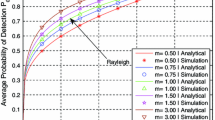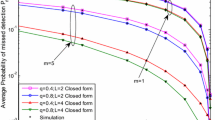Abstract
Energy detection is the most widely used technique in cognitive radio networks to enable opportunistic spectrum access. In this paper, the problem of energy detection of an unknown deterministic signal over fading channels is revisited. More particularly, a new closed-form mathematical expression is derived for the average probability of detection of the energy detector (ED) over \({\upalpha }-{\upmu }\) generalized fading channels with selection combining (SC) diversity reception. The derived expression is general and includes as special cases Nakagami-m, Weibull, Gamma, Rayleigh and Exponential distributions. This expression is useful to quantify the performance improvement of the ED with SC diversity reception.






Similar content being viewed by others
References
Haykin, S. (2005). Cognitive radio: Brain-empowered wireless communications. IEEE Journal on Selected Areas in Communications, 23(2), 201–220.
Yucek, T., & Arslan, H. (2009). A survey of spectrum sensing algorithms for cognitive radio applications. IEEE Communication Surveys & Tutorials, 11(1), 116–130.
Urkowitz, H. (1967). Energy detection of unknown deterministic signals. Proceedings of the IEEE, 55(4), 523–531.
Simon, M. K., & Alouini, M. S. (2005). Digital communication over fading channels (2nd ed.). New York: Wiley-Interscience.
Yacoub, M. D. (2007). The \({\alpha }-{\mu }\) distribution: A physical fading model for the stacy distribution. IEEE Transactions on Vehicular Technology, 56(1), 27–34.
Kostylev, V. (2002). Energy detection of a signal with random amplitude. In Proceedings of the IEEE international conference on communications (ICC’02) (pp. 1606–1610). New York, NY, May 2002.
Digham, F. F., Alouni, M. S., & Simon, M. K. (2007). On the energy detection of unknown signals over fading channels. IEEE Transactions on Communications, 55(1), 21–24.
Herath, S. P., Rajatheva, N., & Tellambura, C. (2011). Energy detection of unknown signals in fading and diversity reception. IEEE Transactions on Communications, 59(9), 2443–2453.
Fathi, Y., & Tawfik, M. H. (2012). Versatile performance expression for energy detector over \({\alpha }-{\mu }\) generalised fading channels. Electronics Letters, 48(17), 1081–1082.
Magableh, A. M., & Matalgah, M. M. (2009). Moment generating function of the generalized \({\alpha }-{\mu }\) distribution with applications. IEEE Communications Letters, 13(6), 411–413.
Alouini, M. S., & Goldsmith, A. J. (1999). Capacity of Rayleigh fading channels under different adaptive transmission and diversity combining technique. IEEE Transactions on Vehicular Technology, 48, 1165–1181.
Prudnikov, A. P., Brychkov, Yu A, & Marichev, O. I. (1990). Integrals and series (Vol. 3). New York: Gordon and Breach.
Olver, F. W. J., Lozier, D. W., Boisvert, R. F., & Clark, C. W. (2010). NIST handbook of mathematical functions. New York, NY: Cambridge University Press.
Digham, F., Alouini, M., & Simon, M. (2003). On the energy detection of unknown signals over fading channels. In Proceedings of the IEEE international conference on communications (Vol. 5, pp. 3575–3579).
Gradshteyn, I. S., Ryzhik, I. M., Jeffrey, Alan, & Zwillinger, Daniel. (2007). Table of integrals, series, and products (7th ed.). Amsterdam: Academic Press/Elsevier.
Author information
Authors and Affiliations
Corresponding author
Appendix: Evaluation of \(\bar{P}_{d,\alpha \mu ,sc}\)
Appendix: Evaluation of \(\bar{P}_{d,\alpha \mu ,sc}\)
The generalized Marcum Q-function \(\hbox {Q}_{\mathrm{u}} \left( {\sqrt{2{{\upgamma }}},\sqrt{{{\uplambda }}}} \right) \) in (10) can be rewritten into series representation using [4, eq.(4.74)] as follows:
In addition, the term \(\left( {1-\frac{{\varGamma } \left( {\mu ,\mu \left( {\frac{\gamma }{\bar{\gamma } }} \right) ^{\alpha /2}} \right) }{{\varGamma } \left( \mu \right) }}\right) ^{L-1}\) in (10) can be simplified into series representation by means of binomial and then multinomial expansions, respectively, as follows:
-
Binomial expansion
$$\begin{aligned} \left( {1-\frac{{\varGamma } \left( {\mu ,\mu \left( {\frac{\gamma }{\bar{\gamma } }} \right) ^{\alpha /2}} \right) }{{\varGamma } \left( \mu \right) }} \right) ^{L-1}=\mathop \sum \limits _{i=0}^{L-1} \left( {-1} \right) ^{i}\left( {{\begin{array}{l} {L-1} \\ i \\ \end{array} }} \right) \left( {\frac{{\varGamma } \left( {\mu ,\mu \left( {\frac{\gamma }{\bar{\gamma } }} \right) ^{\alpha /2}} \right) }{{\varGamma } \left( \mu \right) }} \right) ^{i}\quad \quad \end{aligned}$$(16)Using [15, eq. (8.352-4)] with the help of the equality \({\varGamma } \left( \mu \right) =\left( {\mu -1} \right) !\) and taking into consideration integer values only for the \(\mu \) parameter, it follows that:
$$\begin{aligned} \frac{{\varGamma } \left( {\mu ,\mu \left( {\frac{\gamma }{\bar{\gamma } }} \right) ^{\alpha /2}} \right) }{{\varGamma } \left( \mu \right) }=e^{-\mu \left( {\frac{\gamma }{\bar{\gamma } }} \right) ^{\alpha /2}}\mathop \sum \limits _{m=0}^{\mu -1} \frac{\left( {\mu \left( {\frac{\gamma }{\bar{\gamma } }} \right) ^{\alpha /2}} \right) ^{m}}{m!}\quad \quad \end{aligned}$$(17) -
Multinomial expansion
$$\begin{aligned} \left( {e^{-\mu \left( {\frac{\gamma }{\bar{\gamma } }} \right) ^{\alpha /2}}\mathop \sum \limits _{m=0}^{\mu -1} \frac{\left( {\mu \left( {\frac{\gamma }{\bar{\gamma } }} \right) ^{\alpha /2}} \right) ^{m}}{m!}} \right) ^{i}=e^{-i\mu \left( {\frac{\gamma }{\bar{\gamma } }} \right) ^{\alpha /2}}\mathop \sum \limits _{m=0}^{i\left( {\mu -1} \right) } \beta _{mi} \left( \mu \right) \left( {\mu \left( {\frac{\gamma }{\bar{\gamma } }} \right) ^{\alpha /2}} \right) ^{m}\quad \quad \end{aligned}$$(18)where \(\beta _{mi} \left( \mu \right) \) is the multinomial expansion coefficient which can be computed recursively as illustrated in [4, eq.(9.124)].
Substituting (18) into (16) and then substituting (16) and (15) into (10), the average probability of detection can be expressed as:
Following similar manipulation steps to those leading to [9, eq.(7)], the integral in (19) can be put in the form of Laplace transform. Hence, using [12, 2.2.1-22] the average probability of detection in (11) follows.
Rights and permissions
About this article
Cite this article
Darawsheh, H.Y., Jamoos, A. Performance Analysis of Energy Detector Over \(\alpha -\mu \) Fading Channels with Selection Combining. Wireless Pers Commun 77, 1507–1517 (2014). https://doi.org/10.1007/s11277-013-1595-9
Published:
Issue Date:
DOI: https://doi.org/10.1007/s11277-013-1595-9




